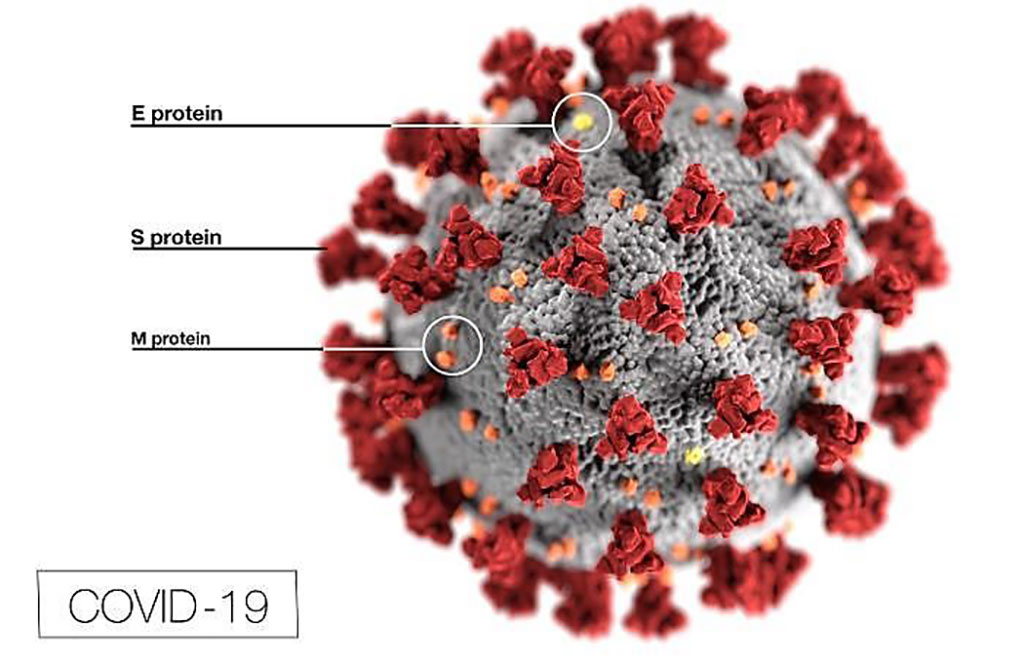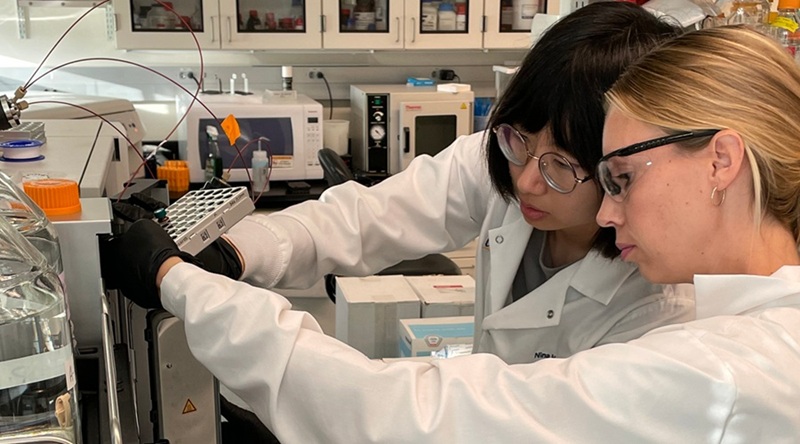Certain Cytokines Not Associated with Severity of COVID-19 Symptoms
|
By LabMedica International staff writers Posted on 24 Jun 2020 |

Image: This illustration reveals ultrastructural morphology exhibited by coronaviruses. Note the spikes that adorn the outer surface of the virus, which impart the look of a corona surrounding the virion, when viewed electron microscopically (Photo courtesy of Centers for Disease Control and Prevention).
The pandemic outbreak of coronavirus disease 2019 (COVID-19) is sharply spreading all over the world. The severity of a viral disease usually is positive association with immune-mediated inflammatory responses. The aggressive and persistent inflammatory response leads to high risk of multiorgan failure and death.
The overproduction inflammatory cytokines results in cytokine storm. Cytokine storm indicates excessive release of pro-inflammatory cytokines including C-reactive protein (CRP) and pro-inflammatory cytokines (IL-2, IL-4, TNF-α, IFN-γ). There is a body of evidences suggests that severe COVID-19 patients have cytokine storm.
Scientists at the Harbin Medical University (Harbin, China) and their colleagues studied patients aged 39 to 85 years old, who were confirmed to be SARS-CoV-2 positive via nasopharyngeal swabs. Further, clinical characteristics and chest CT scans indicated that these patients had severe COVID-19. All patients were admitted in ICU with hypoxemic respiratory failure. Of these patients, five (20%) had hypertension and five (20%) had diabetes. All 25 patients were discharged from the ICU to the hospital ward before being discharged home.
The scientists analyzed serum inflammatory cytokines and immune cells in these patients and found that CRP (range: 0.499-9.75 mg/L; reference value: 0-10 mg/L), IL-2 (range: 0.67-2.59 pg/L; reference value: 0.08-5.71 pg/mL), IL-4 (range: 0-2.27 pg/L; reference value: 0.1-2.8 pg/L), TNF-α (range: 0-1.86 pg/L; reference value: 0.1-2.31 pg/L) and IFN-γ (range: 0.51-3.24 pg/L; reference value: 0.16-7.42 pg/L) were in the normal value range compared to the reference value. These cases showed that IL-2, IL-4, TNF-α, IFN-γ and C reactive protein level is not associated with severe COVID-19 pathology.
The investigators also reported that levels of IL-6 and IL-10 in some severe COVID-19 patients were over the reference values, indicating that these patients had severe clinical characteristics independent of circulating levels of IL-2, IL-4, TNF-α, IFN-γ and CRP. IL-6 levels in 16 patients were above the reference range of 1.18-5.3 pg/L, with levels of 0-36.3 pg/L recorded in all 25 patients. In addition, 14 patients had IL-10 levels above the reference range of 0.19-4.91 pg/L, with levels of 4.96-12.44 pg/L observed across the 25 patients.
The authors concluded that some reports had shown cytokine storm was correlated with severity and mortality of COVID-19 patients, but the correlation does not indicate causation. More viral replication also could drive consequent severity of COVID-19. The authors said that the hypothesis that blocking cytokine storm eases COVID-19 severity needs to be more carefully investigated based on their observation. The study was published on June 10, 2020 in the Journal of Medical Virology.
Related Links:
Harbin Medical University
The overproduction inflammatory cytokines results in cytokine storm. Cytokine storm indicates excessive release of pro-inflammatory cytokines including C-reactive protein (CRP) and pro-inflammatory cytokines (IL-2, IL-4, TNF-α, IFN-γ). There is a body of evidences suggests that severe COVID-19 patients have cytokine storm.
Scientists at the Harbin Medical University (Harbin, China) and their colleagues studied patients aged 39 to 85 years old, who were confirmed to be SARS-CoV-2 positive via nasopharyngeal swabs. Further, clinical characteristics and chest CT scans indicated that these patients had severe COVID-19. All patients were admitted in ICU with hypoxemic respiratory failure. Of these patients, five (20%) had hypertension and five (20%) had diabetes. All 25 patients were discharged from the ICU to the hospital ward before being discharged home.
The scientists analyzed serum inflammatory cytokines and immune cells in these patients and found that CRP (range: 0.499-9.75 mg/L; reference value: 0-10 mg/L), IL-2 (range: 0.67-2.59 pg/L; reference value: 0.08-5.71 pg/mL), IL-4 (range: 0-2.27 pg/L; reference value: 0.1-2.8 pg/L), TNF-α (range: 0-1.86 pg/L; reference value: 0.1-2.31 pg/L) and IFN-γ (range: 0.51-3.24 pg/L; reference value: 0.16-7.42 pg/L) were in the normal value range compared to the reference value. These cases showed that IL-2, IL-4, TNF-α, IFN-γ and C reactive protein level is not associated with severe COVID-19 pathology.
The investigators also reported that levels of IL-6 and IL-10 in some severe COVID-19 patients were over the reference values, indicating that these patients had severe clinical characteristics independent of circulating levels of IL-2, IL-4, TNF-α, IFN-γ and CRP. IL-6 levels in 16 patients were above the reference range of 1.18-5.3 pg/L, with levels of 0-36.3 pg/L recorded in all 25 patients. In addition, 14 patients had IL-10 levels above the reference range of 0.19-4.91 pg/L, with levels of 4.96-12.44 pg/L observed across the 25 patients.
The authors concluded that some reports had shown cytokine storm was correlated with severity and mortality of COVID-19 patients, but the correlation does not indicate causation. More viral replication also could drive consequent severity of COVID-19. The authors said that the hypothesis that blocking cytokine storm eases COVID-19 severity needs to be more carefully investigated based on their observation. The study was published on June 10, 2020 in the Journal of Medical Virology.
Related Links:
Harbin Medical University
Latest Microbiology News
- Blood-Based Diagnostic Method Could Identify Pediatric LRTIs
- Rapid Diagnostic Test Matches Gold Standard for Sepsis Detection
- Rapid POC Tuberculosis Test Provides Results Within 15 Minutes
- Rapid Assay Identifies Bloodstream Infection Pathogens Directly from Patient Samples
- Blood-Based Molecular Signatures to Enable Rapid EPTB Diagnosis
- 15-Minute Blood Test Diagnoses Life-Threatening Infections in Children
- High-Throughput Enteric Panels Detect Multiple GI Bacterial Infections from Single Stool Swab Sample
- Fast Noninvasive Bedside Test Uses Sugar Fingerprint to Detect Fungal Infections
- Rapid Sepsis Diagnostic Device to Enable Personalized Critical Care for ICU Patients
- Microfluidic Platform Assesses Neutrophil Function in Sepsis Patients
- New Diagnostic Method Confirms Sepsis Infections Earlier
- New Markers Could Predict Risk of Severe Chlamydia Infection
- Portable Spectroscopy Rapidly and Noninvasively Detects Bacterial Species in Vaginal Fluid
- CRISPR-Based Saliva Test Detects Tuberculosis Directly from Sputum
- Urine-Based Assay Diagnoses Common Lung Infection in Immunocompromised People
- Saliva Test Detects Implant-Related Microbial Risks
Channels
Clinical Chemistry
view channel
Online Tool Detects Drug Exposure Directly from Patient Samples
Doctors often rely on patient interviews and medical records to determine what medications a person has taken, but this information is frequently incomplete. People may forget drugs they used, take over-the-counter... Read more
Chemical Imaging Probe Could Track and Treat Prostate Cancer
Prostate cancer remains a leading cause of illness and death among men, with many patients eventually developing resistance to standard hormone-blocking therapies. These drugs often lose effectiveness... Read moreMolecular Diagnostics
view channel
New 15-Minute Hepatitis C Test Paves Way for Same-Day Treatment
Chronic hepatitis C infection affects an estimated 50 million people worldwide and causes around 242,000 deaths each year, largely due to cirrhosis and liver cancer. Although the infection is curable with... Read more
Ovarian Cancer Assay Outperforms Traditional Tests in Early Disease Detection
Globally, ovarian cancer is one of the deadliest cancers affecting women. Traditionally, early diagnosis of ovarian cancer has been challenging. Many ovarian cancers are diagnosed only after they have... Read moreHematology
view channel
MRD Tests Could Predict Survival in Leukemia Patients
Acute myeloid leukemia is an aggressive blood cancer that disrupts normal blood cell production and often relapses even after intensive treatment. Clinicians currently lack early, reliable markers to predict... Read more
Platelet Activity Blood Test in Middle Age Could Identify Early Alzheimer’s Risk
Early detection of Alzheimer’s disease remains one of the biggest unmet needs in neurology, particularly because the biological changes underlying the disorder begin decades before memory symptoms appear.... Read more
Microvesicles Measurement Could Detect Vascular Injury in Sickle Cell Disease Patients
Assessing disease severity in sickle cell disease (SCD) remains challenging, especially when trying to predict hemolysis, vascular injury, and risk of complications such as vaso-occlusive crises.... Read more
ADLM’s New Coagulation Testing Guidance to Improve Care for Patients on Blood Thinners
Direct oral anticoagulants (DOACs) are one of the most common types of blood thinners. Patients take them to prevent a host of complications that could arise from blood clotting, including stroke, deep... Read moreMicrobiology
view channel
Blood-Based Diagnostic Method Could Identify Pediatric LRTIs
Lower-respiratory tract infections (LRTIs) are a leading cause of illness and death worldwide, and pneumonia is the leading infectious cause of death in children under five, claiming the lives of over... Read more
Rapid Diagnostic Test Matches Gold Standard for Sepsis Detection
Sepsis kills 11 million people worldwide every year and generates massive healthcare costs. In the USA and Europe alone, sepsis accounts for USD 100 billion in annual hospitalization expenses.... Read moreRapid POC Tuberculosis Test Provides Results Within 15 Minutes
Tuberculosis remains one of the world’s deadliest infectious diseases, and reducing new cases depends on identifying individuals with latent infection before it progresses. Current diagnostic tools often... Read more
Rapid Assay Identifies Bloodstream Infection Pathogens Directly from Patient Samples
Bloodstream infections in sepsis progress quickly and demand rapid, precise diagnosis. Current blood-culture methods often take one to five days to identify the pathogen, leaving clinicians to treat blindly... Read morePathology
view channel
Rapid Low-Cost Tests Can Prevent Child Deaths from Contaminated Medicinal Syrups
Medicinal syrups contaminated with toxic chemicals have caused the deaths of hundreds of children worldwide, exposing a critical gap in how these products are tested before reaching patients.... Read more
Tumor Signals in Saliva and Blood Enable Non-Invasive Monitoring of Head and Neck Cancer
Head and neck cancers are among the most aggressive malignancies worldwide, with nearly 900,000 new cases diagnosed each year. Monitoring these cancers for recurrence or relapse typically relies on tissue... Read more
Common Health Issues Can Influence New Blood Tests for Alzheimer’s Disease
Blood-based tests for Alzheimer’s disease are transforming diagnosis by offering a simpler alternative to spinal taps and brain imaging. However, many people evaluated at memory clinics also live with... Read more
Blood Test Formula Identifies Chronic Liver Disease Patients with Higher Cancer Risk
Chronic liver disease affects millions worldwide and can progress silently to hepatocellular carcinoma (HCC), one of the deadliest cancers globally. While surveillance guidelines exist for patients with... Read moreTechnology
view channel
Machine Learning Models Diagnose ALS Earlier Through Blood Biomarkers
Amyotrophic lateral sclerosis (ALS) is a rapidly progressive neurodegenerative disease that is notoriously difficult to diagnose in its early stages. Early symptoms often overlap with other neurological... Read more
Artificial Intelligence Model Could Accelerate Rare Disease Diagnosis
Identifying which genetic variants actually cause disease remains one of the biggest challenges in genomic medicine. Each person carries tens of thousands of DNA changes, yet only a few meaningfully alter... Read moreIndustry
view channel
Abbott Acquires Cancer-Screening Company Exact Sciences
Abbott (Abbott Park, IL, USA) has entered into a definitive agreement to acquire Exact Sciences (Madison, WI, USA), enabling it to enter and lead in fast-growing cancer diagnostics segments.... Read more







 assay.jpg)











